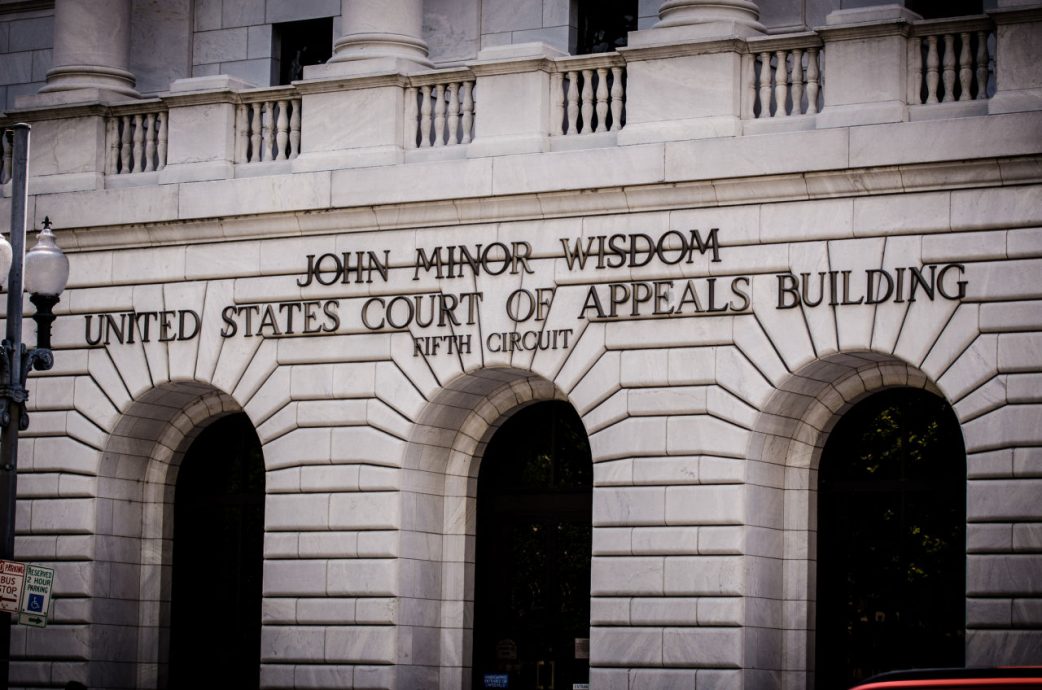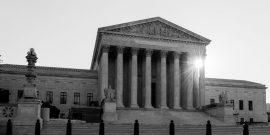The Supreme Court is independent, yes, but Congress has several options for exercising control over the justices.
COVID Vaccines: A Constitutional Mandate?
Last Friday, November 5, the federal government’s Occupational Safety and Health Administration (OSHA) issued an “Emergency Temporary Standard” (“ETS”) requiring that businesses with 100 or more employees implement one of two COVID-19 policies: Companies must require vaccinations for all their employees or, alternatively, provide employees the choice either of getting vaccinated or getting tested “regularly” and wearing a facemask at work. The ETS would cover upwards of 100 million American workers. Almost immediately after its release on Friday, some twenty-six states filed multiple suits to stop the implementation of this ETS, asserting constitutional and statutory challenges to it. On Saturday, November 6, the Fifth Circuit U.S. Court of Appeals, which covers Texas, Louisiana, and Mississippi, issued a stay on enforcing the ETS pending “expedited judicial review.”
While the Fifth Circuit wrote in its stay order that the states’ petition gave it “cause to believe there are grave statutory and constitutional issues with the Mandate,” it did not cite what those issues were, nor did the states’ petition itself sketch those issues. A hint of what those issues might be, however, is provided in the petition filed by eleven states challenging the ETS in the Eighth Circuit Court of Appeals. There the states also challenge both the constitutional and statutory basis for the ETS.
Judges normally accord substantial deference to the government on constitutional challenges to laws or regulations that do not touch on suspect classifications (like race or religion). So, too, judges normally accord substantial deference to administrative rules promulgated by agencies like OSHA. Yet because “Emergency Temporary Standards” can skip important parts of the lengthier review process used when adopting ordinary, non-emergency rules, the statute authorizing adoption of emergency standards imposes a higher evidentiary threshold.
Courts have taken this statutory skepticism to heart. OSHA has tried to use the ETS process only nine times in its history. Of those nine ETS attempts, six were challenged in court. And of those six challenged, only one ETS was upheld. Overall, less than half of OSHA’s proffered ETS’s have been fully implemented. That is a surprisingly low percentage.
Here’s how I would handicap the odds for some of the more obvious challenges to OSHA’s COVID-19 ETS on constitutional and statutory/administrative grounds.
Constitutional Challenges
The main constitutional challenge to OSHA’s COVID-19 ETS is that it infringes on the traditional authority of the states—their “police powers”—to make policy concerning public health. The petition the eleven states filed in the Eighth Circuit argues:
For over a century, the U.S. Supreme Court has recognized that policies on compulsory vaccination lie within the police powers of the States, and that “[t]hey are matters that do not ordinarily concern the national government.” Jacobson v. Massachusetts, 197 U.S. 11, 38 (1905). Until quite recently, the Biden Administration agreed. The White House stated on July 23 of this year that mandating vaccines is “not the role of the federal government.” But on September 9, 2021, that position underwent a dramatic reversal. . . .
The federal government lacks constitutional authority under its enumerated powers to issue this mandate, and its attempt to do so unconstitutionally infringes on the States’ powers expressly reserved by the Tenth Amendment.
It is true that public health policy—and vaccination policy in particular—is a traditional matter of state concern. And there is some language in court cases of recent decades that judges will provide more rigorous scrutiny to federal policies that impose on traditional matters of state concern. In United States v. Lopez, for example—the first time since the 1930s that the US Supreme Court struck down a congressional statute as beyond Congress’s power to regulate interstate commerce—Justice Kennedy, in a concurring opinion joined by Justice O’Connor, wrote that when Congress attempts to extend its power into new areas, “then at the least [the Court] must inquire whether the exercise of national power seeks to intrude upon an area of traditional state concern.” Given that education “is a traditional concern of the States . . . [the Court has] a particular duty to ensure that the federal-state balance is not destroyed.”
The majority in Lopez suggested much the same, except focusing on criminal justice as the state policy area of interest:
Under our federal system, the States possess primary authority for defining and enforcing the criminal law. When congress criminalizes conduct already denounced as criminal by the States, it effects a change in the sensitive relation between federal and state criminal jurisdiction (citations and internal quotation marks omitted).
Like education and criminal law, public health policy—and vaccination policy in particular—is an area of traditional state concern.
Yet this additional scrutiny appeared in the decision in the form of the unwillingness of the majority in Lopez to extend Congress’s interstate commerce power to non-commercial activity on school grounds. Where the question of the existence of commercial activity is not present, however, there exist well-established, century-old decisions approving congressional legislation even though the legislation overlaps with state police powers. (See, for example, The Lottery Case of 1903, prohibiting interstate movement of lottery tickets, Hipolite Egg Co. v. United States, 1911, which expressly dealt with a matter of public health, and Hoke v. United States in 1913, relating to morals legislation.)
Given that OSHA’s ETS imposes mandates on employers, and that its manifest concern is the workplace transmission of COVID-19, and given the Court’s expansive interpretation of Congress’s interstate commerce power even after Lopez—that is, Congress has the power to regulate activity that substantially affects interstate commerce—it seems most likely that courts will uphold the constitutionality of OSHA’s COVID-19 ETS.
Statutory and Administrative Challenges to OSHA’s COVID-19 ETS
As noted above, less than half of all of OSHA’s Emergency Temporary Standards survived judicial challenge actually to be implemented. Because the ETS process allows for procedural shortcuts, the evidentiary standard that OSHA needs to meet for an ETS is higher than when promulgating ordinary, non-emergency rules. Judges have proven quite willing to require OSHA demonstrate to their satisfaction that the higher evidentiary thresholds required an ETS are in fact met.
Different routes can be taken to challenge the statutory and administrative basis for OSHA’s COVID-19 ETS. In their petition to the Eighth Circuit, the states assert these challenges: First, OSHA took two months to issue an ETS after it had announced its plan. This, the states argue, suggests that OSHA itself does not think the evidence really implies an emergency actually exists. Secondly, OSHA’s rationale for the ETS does not meet the legal requirement that there be “substantial evidence in the record considered as a whole” to adopt the ETS. In particular, OSHA neglects to consider the costs of its mandate. Third, given that President Biden announced the intention to impose the mandate months earlier, the reasons OSHA adduces for the ETS are nothing more than an impermissible “post hoc rationalization” for the mandate. Courts have refused to consider “post hoc rationalizations” asserted in support of administrative rules.
What of these challenges?
First, OSHA does have to meet a higher standard of evidence in setting forth an ETS relative to going through the ordinary process of rulemaking. As the Fifth Circuit noted in Asbestos Information Association v. OSHA,
This court’s decision in Florida Peach Growers v. Department of Labor holds that an ETS is like any other OSHA regulation under pre-enforcement judicial scrutiny for purposes of imposing the statutorily prescribed substantial evidence standard. Consequently, we must take a “harder look” at OSHA’s action than we would if we were reviewing the action under the more deferential arbitrary and capricious standard applicable to agencies governed by the Administrative Procedure Act.
The question then is whether a “grave danger” to worker health exists without the ETS. In their Eighth Circuit petition, the states argue that the delay of two months between announcing the intention to implement the ETS and its actual implementation suggests that a real emergency doesn’t exist. So, too, the delayed implementation of the vaccination requirement until January 4, 2022 might suggest the same. That is, if there’s a real emergency, then why the wait?
I am dubious this part of the challenge will succeed. After all, the very need to meet the “substantial evidence” standard implies the need for OSHA to have written something like its detailed, 154-page justification for its ETS. A two-month period to accumulate the sources and evidence reported in the justification does not seem excessive. After all, a less complete justification for the ETS—one that could have been written in a shorter time—could then have been challenged by states on the basis that it did not provide enough “substantial evidence” to meet the statutory requirement for an ETS. As the court wrote in Asbestos Information Association regarding a period of OSHA’s inaction over a period of several years, “the Agency’s failure to act may be evidence that a situation is not a true emergency, but we agree with OSHA that failure to act does not conclusively establish that a situation is not an emergency.”
I expect that OSHA’s COVID-19 mandate will prove most vulnerable to judicial skepticism of the empirical justification OSHA provides for the ETS.
A similar analysis would track for the two-month wait before enforcement of the mandate begins January 4, 2022. Given the ETS requirement that employers develop plans and monitoring for the requirements, let alone the need for many employees actually to get vaccinated, two months does not seem an excessive lead period. Indeed, without the lead period, costs to employers would presumably be much higher, which would then create a reason itself to challenge the ETS.
Nonetheless, whether there is “substantial evidence” of “grave danger” from workplace transmission of COVID-19 may be a line of challenge that courts may be more willing to entertain. Judges have proven quite willing to dive into the empirical details in reviewing whether OSHA has in fact met the required “substantial-evidence” threshold. For example, the Third Circuit in Dry Color Manufacturers’ Association, Inc. v. Department of Labor, rejected evidence that a substance caused cancer in rats as sufficient to meet the evidentiary standard in application to humans. The court subsequently rejected the ETS. So, too, the absence of proof of sufficiently serious health effects had the Fifth Circuit reject OSHA’s ETS in Florida Peach Growers Association, Inc. v. United States Department of Labor.
The point is that judges have required OSHA actually to prove each connecting point in its rationale for an ETS. It is, for example, insufficient for OSHA to justify its COVID-19 ETS merely by showing that people who have COVID-19 have a higher mortality rate than people who do not contract it. Rather, OSHA needs first to provide “substantial evidence” that it is workers who are in “grave danger.” (Recall, for example, that the highest mortality rates are for people above the age of 70, the vast majority of whom no longer work). Or OSHA’s ETS might be challenged given that cases are currently declining in the U.S. Given the “substantial evidence” requirement, OSHA would need to do more than assert that COVID-19 cases will increase again in the future.
And, last but not least, OSHA needs to provide “substantial evidence” that the workplace itself is the source of the transmission of debilitating cases of COVID-19.
To be sure, OSHA’s 154-page ETS at least covers these bases. But it is particularly on this last point—workplace transmission of COVID-19—that OSHA’s ETS itself manifests over the sufficiency of its empirical case. The problem is the speed with which COVID-19 has developed has not allowed much time for scientific investigations over all aspects of the disease, including specific studies regarding how the virus is transmitted. As a result, OSHA argues in its ETS that publications like newspaper articles that report on workplace transmission of COVID-19 should be accepted as legitimate sources of evidence for the ETS. At least some judges might conclude that the evidence provided on the actual threat of workplace transmission does not rise to the required level of providing the “substantial evidence” for the ETS. (And OSHA does cite more than newspaper articles on workplace transmission. It’s just that the ETS itself draws attention to its use of non-scientific sources on this point in particular.)
The states in their Eighth Circuit petition challenge the ETS arguing that, since President Biden announced that the ETS would be forthcoming, the evidence provided for it in the 154 pages of supporting material is nothing more than “post hoc rationalization”—that the reasons an agency provides for an administrative action when challenged in court were not yet articulated by the agency at the time the action was originally taken. The Supreme Court rejected “post hoc rationalization” as an appropriate basis for administrative actions in Department of Homeland Security v. Regents of University of California and circuit courts have rejected it in specific application to an OSHA ETS in Asbestos Information Association v. OSHA.
Yet the state petition asserts the “post hoc rationalization” challenge in a novel form: The petition asserts that because of the earlier announcement by the president of the intention to provide an ETS regarding COVID-19, the ETS itself therefore provides only a post hoc rationalization for a decision that was already taken. This is a different setting than the objection that an agency provides a novel justification for a formal agency action when challenged in a court than it provided when it took the formal action in the first place.
Where does this leave us? Successful state-level legal challenges to “emergency” orders have come mainly in the form of arguments that governors and administrators have exceeded statutory authorization rather than in the form of constitutional attacks on those actions. I expect that will be the case for state challenges to OSHA’s COVID-19 mandate as well. As in past cases in which courts have prevented implementation of over half of OSHA Emergency Temporary Standards, OSHA’s COVID-19 mandate will prove most vulnerable to judicial skepticism of the empirical justification OSHA provides for the ETS. In particular, whether judges are persuaded that OSHA has in fact met the high threshold of providing “substantial evidence” for each link in the argumentative chain needed to support its COVID-19 ETS.



